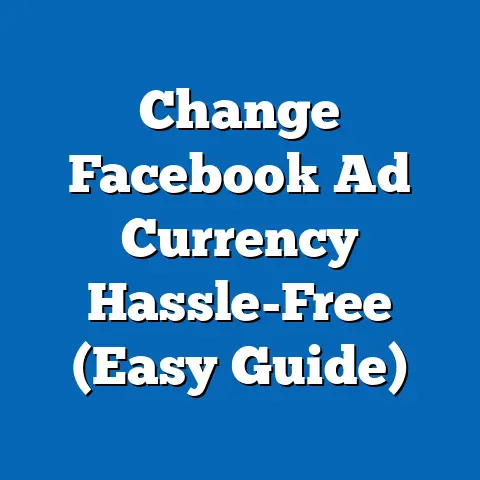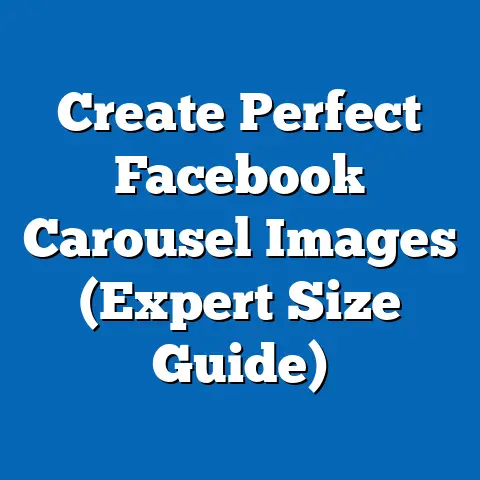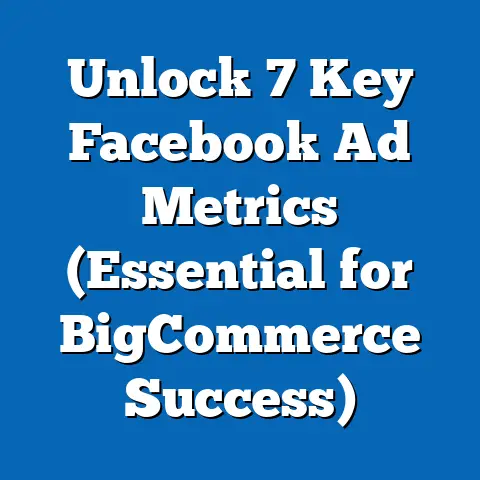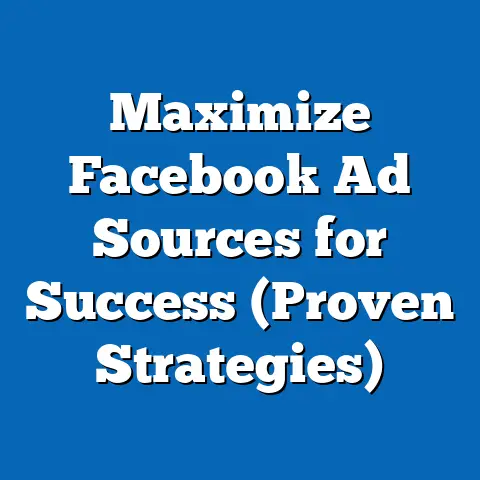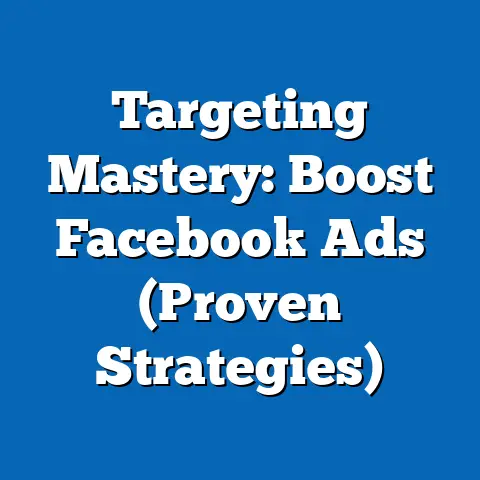Maximize Ads Success with Facebook Pics (Ethical Strategies)
I’ve seen firsthand how a single, well-crafted image can transform a struggling Facebook ad campaign into a roaring success. But in today’s digital landscape, it’s not just about grabbing attention; it’s about earning trust. This article dives deep into how you can leverage the power of visual content on Facebook while staying true to ethical principles. We’ll explore current trends, the psychology behind effective imagery, and actionable strategies to help you create campaigns that are both successful and responsible.
Current Trends in Facebook Advertising
Let’s face it: Facebook is a behemoth in the advertising world. With billions of active users, it’s a prime platform for businesses of all sizes. But the game is constantly evolving. According to recent statistics, visual content now dominates the Facebook landscape. In fact, ads with images receive significantly higher engagement rates than text-only ads. I’ve noticed this trend intensify over the past few years.
One of the biggest trends I’m seeing is the rise of short-form video ads. Think TikTok, but tailored for Facebook’s audience. These bite-sized videos are perfect for capturing attention quickly and conveying your message in a memorable way. Carousel ads, which allow you to showcase multiple products or features in a single ad unit, are also incredibly popular and effective. I’ve personally used carousel ads to highlight different aspects of a product line, and the results have been fantastic.
Another trend that’s gaining traction is the use of user-generated content (UGC). Instead of relying solely on polished, professional photos, brands are incorporating authentic images and videos created by their customers. This adds a layer of credibility and relatability that traditional advertising often lacks. I remember working with a local coffee shop that ran a campaign featuring photos submitted by their customers enjoying their coffee. The engagement skyrocketed because people saw themselves reflected in the ads.
Mobile-first design is no longer optional; it’s essential. The majority of Facebook users access the platform on their smartphones, so your images need to look stunning on smaller screens. This means prioritizing high-quality imagery, clear messaging, and a visual hierarchy that guides the viewer’s eye.
However, amidst all these exciting trends, there’s a growing concern for authenticity and transparency. Consumers are becoming increasingly savvy and skeptical of overly polished or misleading advertising. This is why ethical practices are more important than ever. We’re moving towards an era where honesty and integrity are just as crucial as creativity.
Takeaway: Stay on top of current trends in Facebook advertising, such as short-form video, carousel ads, and UGC. Prioritize mobile-first design and always prioritize ethical practices to build trust with your audience.
The Psychological Impact of Images
Images aren’t just pretty pictures; they’re powerful tools that can influence consumer behavior and decision-making. Our brains are wired to process visual information much faster than text. A compelling image can grab attention in a split second, evoke emotions, and create a lasting impression. I’ve seen this play out time and time again in my own campaigns.
Colors play a significant role in how we perceive images. For example, blue often evokes feelings of trust and security, while red can create a sense of excitement or urgency. The composition of an image – how the elements are arranged – can also impact its effectiveness. A well-balanced image with a clear focal point will be more visually appealing and easier to understand.
Storytelling is another key element. The most effective visual ads tell a story, even if it’s just a subtle one. They create a narrative that resonates with the viewer’s values, aspirations, or pain points. I once worked on a campaign for a non-profit organization that used images of the people they were helping. These images told a powerful story of hope and resilience, which led to a significant increase in donations.
Let’s look at some examples. Dove’s “Real Beauty” campaign, which featured images of diverse women, challenged traditional beauty standards and resonated deeply with audiences. This campaign not only generated positive brand sentiment but also drove sales. Similarly, Airbnb’s ads often showcase stunning photos of unique accommodations around the world, inspiring viewers to travel and explore.
Takeaway: Understand the psychological impact of images and use colors, composition, and storytelling to create compelling visual ads. Learn from successful campaigns and adapt their strategies to your own business.
Ethical Strategies for Using Images in Ads
Now, let’s get to the heart of the matter: ethical strategies. In today’s world, it’s not enough to simply create visually appealing ads; you also need to ensure they’re honest, respectful, and responsible. This is where ethical considerations come into play.
Authenticity and Honesty
I believe that authenticity is the cornerstone of ethical advertising. Using real images of your products, services, or customers can build trust and credibility with your audience. Avoid relying solely on stock photos, which can often feel generic and impersonal. I’ve found that when I use authentic images in my campaigns, the engagement rates are significantly higher.
For example, if you’re selling handmade jewelry, use photos of your actual products being worn by real people. If you’re promoting a local restaurant, use images of your actual dishes and the happy customers enjoying them. Showcasing the real thing can make a huge difference.
Diversity and Inclusivity
Representing diverse groups in your advertising can resonate with a broader audience and demonstrate your commitment to inclusivity. However, it’s important to ensure that your representation is genuine and not tokenistic. Don’t simply include diverse faces for the sake of it; make sure your images reflect the real diversity of your customer base and the world around you.
I’ve seen brands that have successfully incorporated diversity by featuring people of different races, ethnicities, genders, sexual orientations, and abilities in their ads. This not only makes their advertising more relatable but also sends a positive message about their values.
Transparency in Sponsored Content
If you’re running sponsored content or working with influencers, it’s crucial to be transparent about the nature of the relationship. Clearly mark sponsored content with labels like “#ad” or “sponsored” to avoid misleading your audience. Additionally, ensure that the images used in your sponsored content accurately depict the products or services being promoted.
I’ve come across instances where influencers have promoted products using heavily filtered or edited images, which can be deceptive. It’s important to work with influencers who are committed to transparency and honesty.
Respecting Copyright and Privacy
Using images without permission or violating copyright laws can lead to legal trouble and damage your brand’s reputation. Always obtain the necessary permissions before using images in your ads. If you’re using images of people, make sure you have their consent and that they’re aware of how their images will be used.
I always advise my clients to use original content whenever possible or to purchase images from reputable stock photo sites. It’s also a good idea to include a disclaimer in your ads stating that you respect copyright laws and privacy rights.
Using Data Responsibly
Targeted advertising can be incredibly effective, but it’s important to use consumer data responsibly. Avoid collecting or using data in a way that invades privacy or discriminates against certain groups. Be transparent about how you’re collecting and using data, and give consumers the option to opt out.
I’ve seen brands that have been criticized for using data in a way that felt creepy or intrusive. It’s important to strike a balance between personalization and privacy.
Takeaway: Ethical advertising is not just a moral imperative; it’s also a smart business strategy. By being authentic, inclusive, transparent, respectful, and responsible, you can build trust with your audience and create a positive brand image.
Best Practices for Maximizing Ad Success with Images
Now that we’ve covered the ethical considerations, let’s talk about some best practices for maximizing ad success with images on Facebook.
- Select High-Quality Images: This may seem obvious, but it’s worth emphasizing. Use images that are sharp, well-lit, and visually appealing. Avoid blurry or pixelated images, which can make your ads look unprofessional.
- Optimize for Mobile: As I mentioned earlier, most Facebook users access the platform on their smartphones, so your images need to look great on smaller screens. Use images that are optimized for mobile viewing and ensure that your text is legible on smaller screens.
- Use the Right Image Size and Aspect Ratio: Facebook has specific requirements for image sizes and aspect ratios. Make sure you’re using the correct dimensions to avoid cropping or distortion.
- A/B Test Different Images: A/B testing is a powerful tool for optimizing your ads. Try testing different images to see what resonates best with your target audience. You can test different colors, compositions, or even different models.
- Use Text Overlay Sparingly: Text overlay can be effective for highlighting key messages, but use it sparingly. Too much text can make your ads look cluttered and overwhelming. Facebook also has a text overlay limit, so make sure you’re within the guidelines.
- Tell a Story: As I mentioned earlier, the most effective visual ads tell a story. Use images that evoke emotions, create a narrative, and connect with your audience on a personal level.
- Comply with Facebook’s Ad Policies: Facebook has strict ad policies that you need to comply with. Make sure your images don’t violate any of these policies, such as promoting illegal activities or using misleading claims.
Takeaway: By following these best practices, you can create visually appealing and effective Facebook ads that resonate with your target audience and drive results.
Conclusion
Maximizing ad success on Facebook is a multifaceted endeavor that requires creativity, strategy, and ethical responsibility. By understanding the power of visual content, staying on top of current trends, and adhering to ethical principles, you can create campaigns that are both effective and principled. I encourage you to adopt these strategies and ensure that your advertising efforts are not only successful but also contribute to a more honest and respectful digital landscape. Remember, in the long run, trust and integrity are the most valuable assets you can build with your audience.

